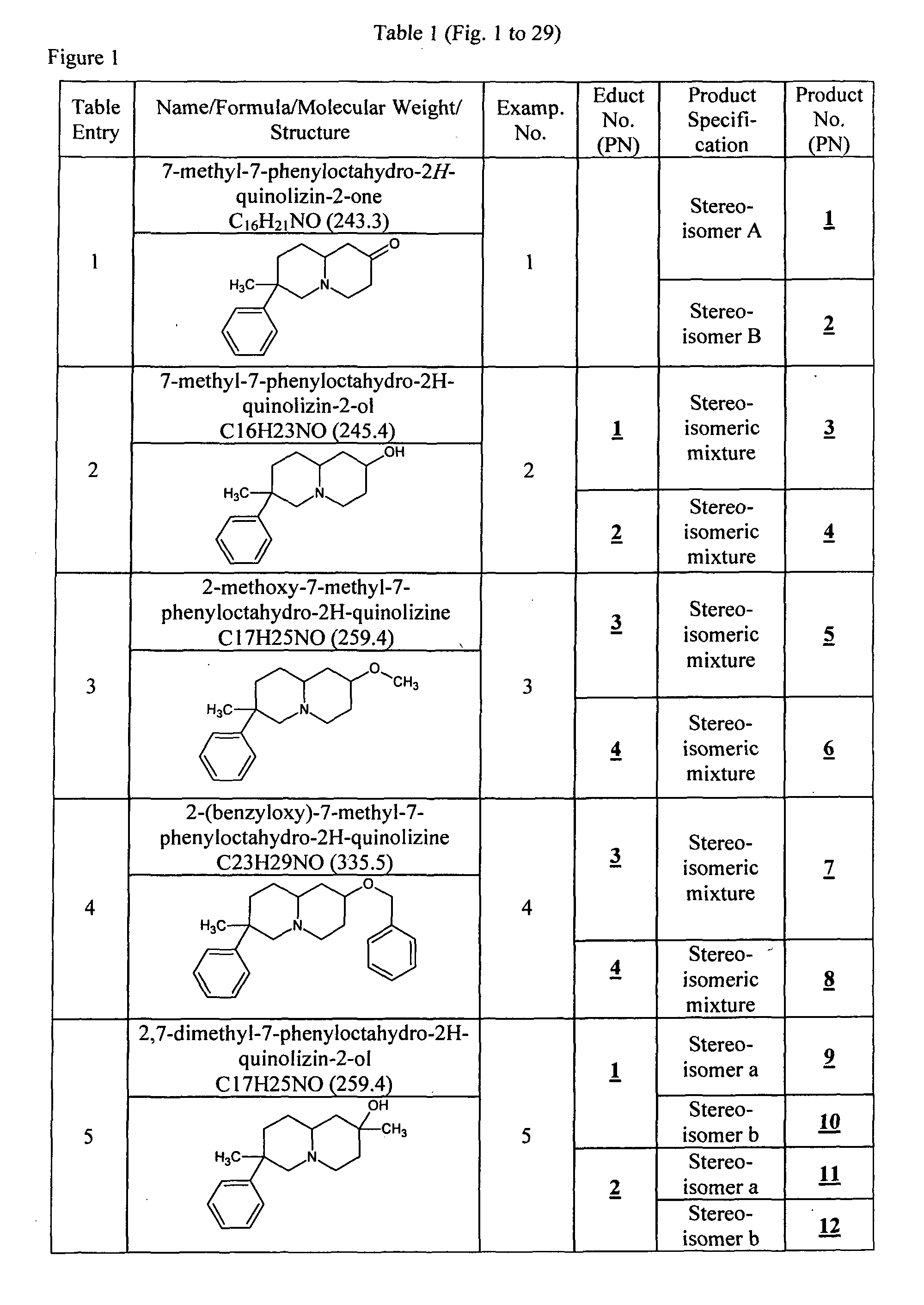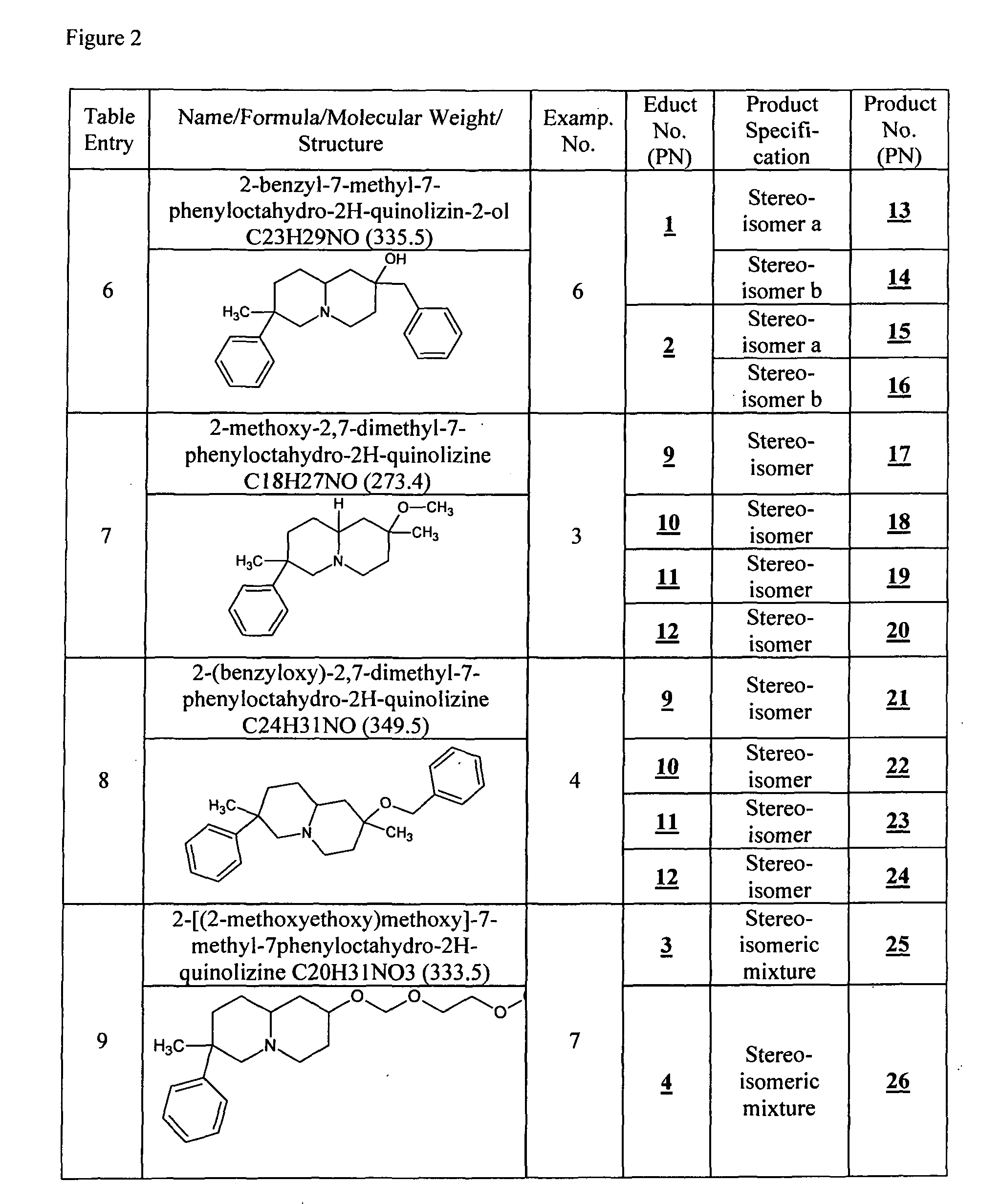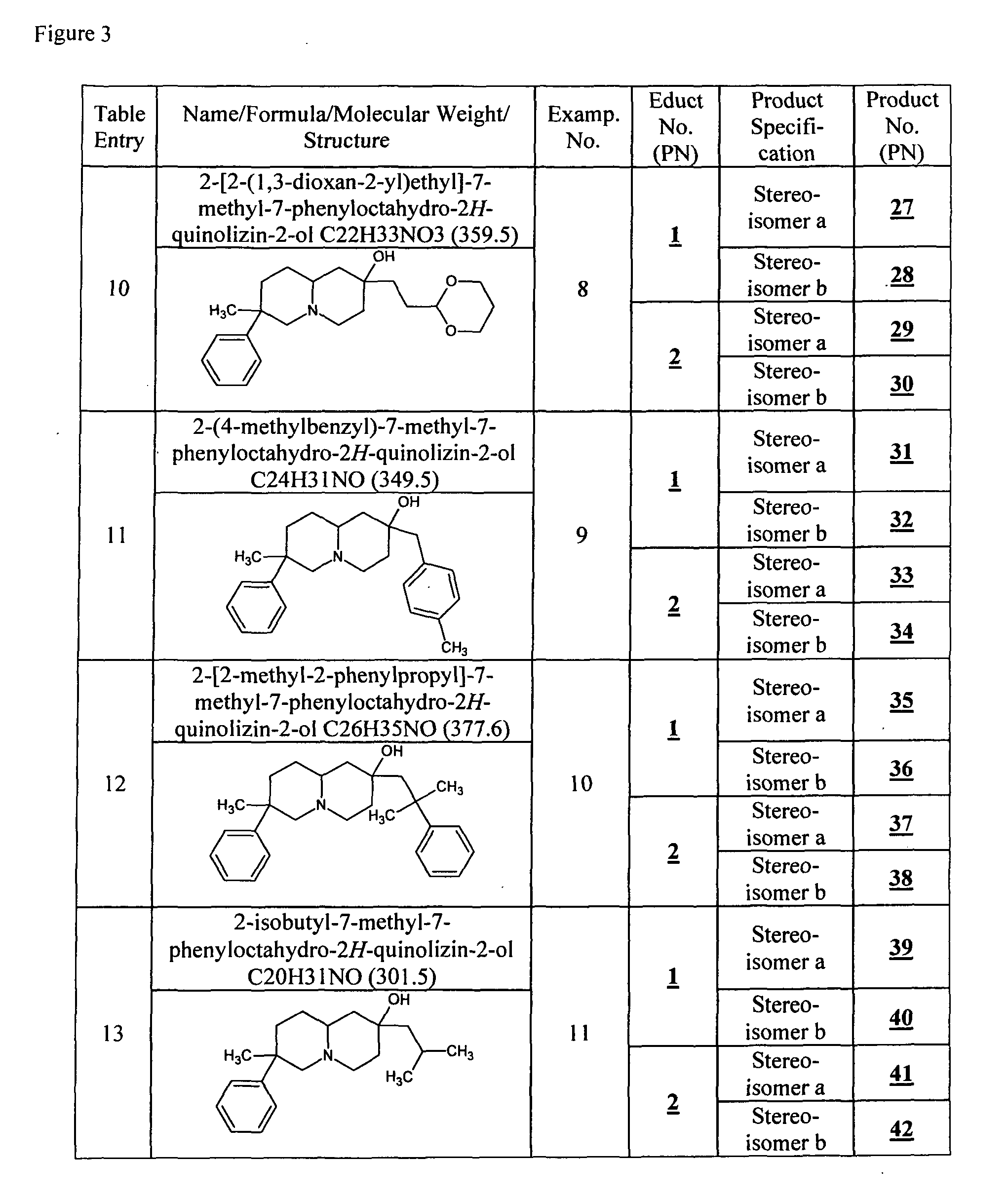Octahydroquinolizines for antidiabetic treatment
a technology of octahydroquinolizines and antidiabetic treatment, which is applied in the field of octahydroquinolizines, can solve the problems of type 1 life-threatening, insufficient insulin secretion,
- Summary
- Abstract
- Description
- Claims
- Application Information
AI Technical Summary
Problems solved by technology
Method used
Image
Examples
example 1
Preparation of Products with Product No. 1 and 2 Following the Procedure of Frank D. King, J. Chem. Soc. Perkin Trans. 1, 447-453 (1986)
[0079]To a suspension of dry DMF (100 ml) and sodium hydride, 60% (4.1 g, 0.17 mol) at 70° C. in a dry and inert atmosphere (Argon) methylphenylacetonitrile (10 ml, 0.075 mol) is added. After stirring at 70° C. for 1 h 3-chloropropionaldehyde diethyl acetal (13.2 g, 0.079 mol) is added drop wise. After stirring at 70° C. for 1 h and cooling to RT, the reaction mixture is poured into 1 L of ice-water. The product is extracted with Et2O (3×200 ml). The combined Et2O extracts are filtered over Na2SO4 and evaporated in vac. to dryness yielding about 19.1 g of crude product which is directly used in the next step. To a suspension of dry THF (115 ml) and LAH (2.43 g, 0.065 mol) in a dry and inert atmosphere (Argon) concentrated sulphuric acid (1.6 ml, 0.03 mol) is added drop wise under cooling with ice-water. After stirring at 0° C. for 1 h, a solution of...
example 2
Preparation of Products 3, 4, 302, 303, 312 and 313
[0081]Product 1, 2, 149, 150, 296 or 297, respectively, dissolved in dry DEE is added slowly to a stirred suspension of 1 eq. LAH in dry DEE in a dry and inert atmosphere (Argon) at RT. After 2 h the reaction mixture is quenched with water, rendered alkaline with NaOH and extracted three times with Et2O. The combined organic layers are dried over Na2SO4, filtered and evaporated in vac. to dryness yielding 3, 4, 302, 303, 312 or 313, respectively.
[0082]HPLC / MS Method A: 3: Stereoisomer I: RTT=2.9 [ms: 246.1 (M+H+)], Stereoisomer II: RTT=3.4 [ms: 246.1 (M+H+)]; 4: Stereoisomer I: RTT=3.9 [ms: 246.1 (M+H+)], Stereoisomer II: RTT=4.6 [ms: 246.1 (M+H+)]; HPLC / MS Method B: 303: Stereoisomer I: RTT=8.9 [ms: 260.2 (M+H+)], Stereoisomer II: RTT=9.1 [ms: 260.2 (M+H+)]; 313: RTT=10.7 [ms: 302.3 (M+H+)]
example 3
Preparation of Products 5, 6, 17 to 20, 45 to 52
[0083]Product 3, 4, 9 to 12, 27 to 30, 39 to 42, respectively, is dissolved in dry DMF, 2 eq. NaH are added and the reaction mixture is stirred at RT for 45 min. 1.2 to 5 eq. MeI are added and the reaction mixture is stirred over night. The reaction mixture is quenched with water and extracted with CH2Cl2. The combined organic phases are dried over MgSO4, filtered and evaporated in vac. to dryness yielding 5, 6, 17 to 20, 45 to 52, respectively. Product 5, 6, 17 to 20, respectively, is purified by CC method B, product 47 and 49, respectively, is purified by CC method D.
[0084]HPLC / MS Method A: 5: Stereoisomer I: RTT=4.6 [ms: 260.1 (M+H+)], Stereoisomer II: RTT=6.2 [ms: 260.1 (M+H+)]; 6: Stereoisomer I: RTT=7.1 [ms: 260.1 (M+H+)], Stereoisomer II: RTT=8.4 [ms: 260.1 (M+H+)]; 17: RTT=6.0 [ms: 274.1 (M+H+), 242.1 (4%, M+H+-MeOH)]; 18: RTT=7.7 [ms: 274.2 (M+H+)]; 19: RTT=7.3 [ms: 274.1 (M+H+), 242.2 (8%, M+H+-MeOH)]; 20: RTT=8.9 [ms: 274.1 ...
PUM
| Property | Measurement | Unit |
|---|---|---|
| temperature | aaaaa | aaaaa |
| volume | aaaaa | aaaaa |
| volume | aaaaa | aaaaa |
Abstract
Description
Claims
Application Information
 Login to View More
Login to View More - R&D
- Intellectual Property
- Life Sciences
- Materials
- Tech Scout
- Unparalleled Data Quality
- Higher Quality Content
- 60% Fewer Hallucinations
Browse by: Latest US Patents, China's latest patents, Technical Efficacy Thesaurus, Application Domain, Technology Topic, Popular Technical Reports.
© 2025 PatSnap. All rights reserved.Legal|Privacy policy|Modern Slavery Act Transparency Statement|Sitemap|About US| Contact US: help@patsnap.com



